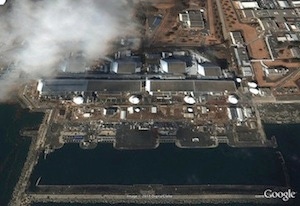Engineers Await More News on Japan Reactor Status
March 16, 2011

Radioactivity levels around a crippled Japanese nuclear reactorrose again on Tuesday, but U.S. experts said they don't yet know whether thereactor or its containment building has been breached, despite a multitude ofmedia reports to the contrary.
Concerns rose yesterday after Japanese officials reportedthat the Unit 2 reactor at the Fukushima Daiichi plant sustained damage to theso-called suppression chamber, which holds water and steam released from thereactor core. Damage to the suppression chamber could be a sign of a largerproblem, they said.
Still, if the plant's steel pressure vessels and itsreinforced concrete containment structures are intact, then the damage to thesurrounding area would be greatly reduced.
"Unless we breach the reactor pressure vessel, we shouldn'tworry too much," noted Professor Ahmad Hassanein, head of the NuclearEngineering Department at Purdue University. "This is not going to be aChernobyl."
Experts in the U.S. also cautioned that they don't know whenthe extent of the damage will be fully understood. "Obviously, radiation levelswere way up and they had to evacuate the vast majority of people on site," saidJeff Terry, an assistant professor of physics at Illinois Institute ofTechnology (IIT). "But since then, the information has been pretty sketchy."
Secondary Buildings Damaged
The issue of a breach is critical because reactor pressurevessels and containment buildings are designed to capture the by-products ofaccidents. During a so-called meltdown, however, fuel rods can overheat andmolten uranium can burn through the nine-inch-thick steel vessel surroundingthe reactor core. In extreme cases, many observers worry that the overheatedfuel could potentially burn through the reinforced concrete floor slab beneaththe reactor, contaminating the ground below. Such a scenario is considered unlikely,however, because the containment building's reinforced concrete floor and roofslabs are at least four feet thick.
Engineers Await More News on Japan Reactor Status_A |
Although countless newspaper and television reports in thepast week have indicated that the containment buildings at Fukushima Daiichi'sNos. 1, 2 and 3 reactors have exploded, experts in this country contend thatthose explosions were confined to corrugated metal structures, which aren'tdesigned to capture a meltdown. They believe the containment buildings inreactor Nos. 1 and 3 are undamaged, but aren't sure about reactor No. 2.
"The main containment buildings are still intact as far aswe know," said James F. Stubbins, a professor of nuclear, plasma andradiological engineering at the University of Illinois. "The explosionsoccurred in what they call 'the secondary containment,' which is a buildingabove and around the primary containment structure."
Engineering experts said that the buildings exploded whenhydrogen gas was released after built-in pressure release valves weretriggered. "As the water in the reactor core starts boiling away, the pressurereaches such incredible levels that if you don't have a valve to release it,the inner containment vessel would rupture," Terry said. "You'd rather releaseradioactive nitrogen with a seven-second half-life than have the containmentvessel blow apart." Terry believes that the gases that built up inside reactorbuildings Nos. 1 and 3 were ignited by electrical sparks from nearby equipment.
High Radioactivity Readings
As a result of the explosions, radioactivity levels rosesharply around the Fukushima Daiichi plant on Tuesday. The NuclearEnergy Institute reported that a dose rate of 1.19 rems per hour wasobserved at the site boundary and dose of 40 rems per hour was seen close tothe plant (a rem is a measure of biological damage to tissue). The 1.19 remreading dropped to about 0.06 rems per hour later in the day, however.
The readings are considered high, engineers said. Onaverage, individuals are subjected to about 0.6 rems per year. Nuclear powerplant workers are typically limited to about 5 rems per year. According the1982 book, Nuclear Power: Both Sidesby Michio Kaku, 1,000 rems would kill a person a few days after exposure, 500rems would kill half of the exposed population within a few weeks, 200-400 remswould cause radiation sickness and hemorrhaging, and 50 rems would cause noimmediate visible effects, but could induce long-term damage.
The higher levels of radioactivity have caused countlessindividuals around the world to purchase potassium iodide tablets, which aresaid prevent accumulation of radioactive iodine in the thyroid. "There's a hugeamount of hysteria right now," Terry said. "As a result, you can't buypotassium iodide in the U.S. at the moment. Every manufacturer has sold out."
Experts say that the only people in definite danger arethose who work at or near the plant. For that reason, many workers are beingshuttled in and out of the plant to shorten their exposure times.
Engineering professors contacted by Design News said that the Japanese plants did extraordinarily wellin withstanding a mammoth earthquake, followed by a tsunami. "Let's not forgetthis was an unprecedented disaster," said Hassanein of Purdue. "I'm impressedthat most of their 50 or so reactors are doing so well."
Still, the jury is out at Fukushima Daiichi reactor No. 2.The Nuclear Energy Institute reported yesterday that the water level in thereactor was approximately five-and-a-half feet below the tops of the 12-footfuel rods in the core. If that's true, it would mean that a great deal ofuranium is exposed to air -- typical reactors contain 40,000 or more rods,bundled in hundreds of 8 x 8 assemblies.
"There's some melting of the fuel going on right now, butit's not what many of use would characterize as a meltdown," said Stubbins ofthe University of Illinois. "We're just keeping our fingers crossed that itstays that way."
About the Author(s)
You May Also Like






